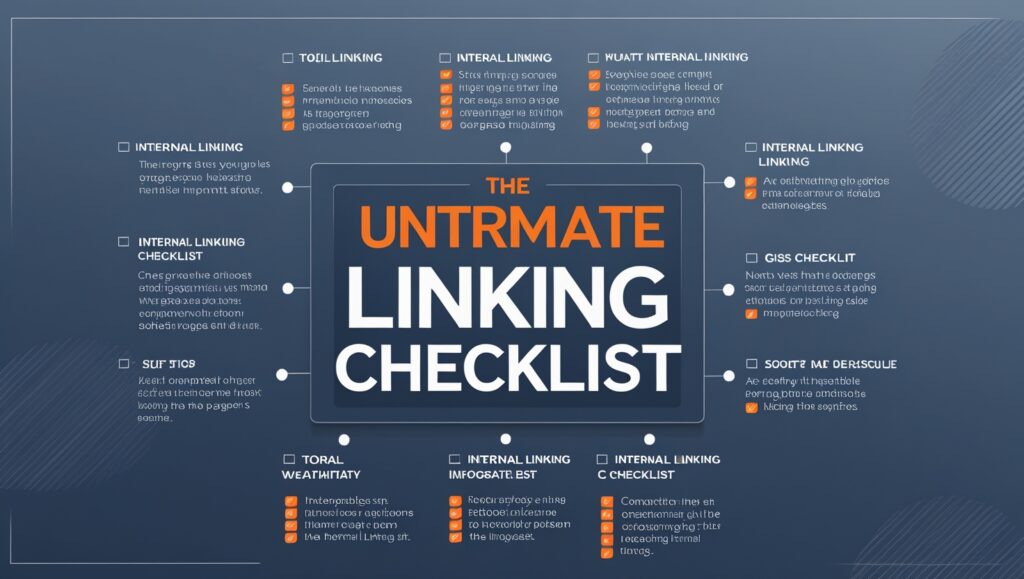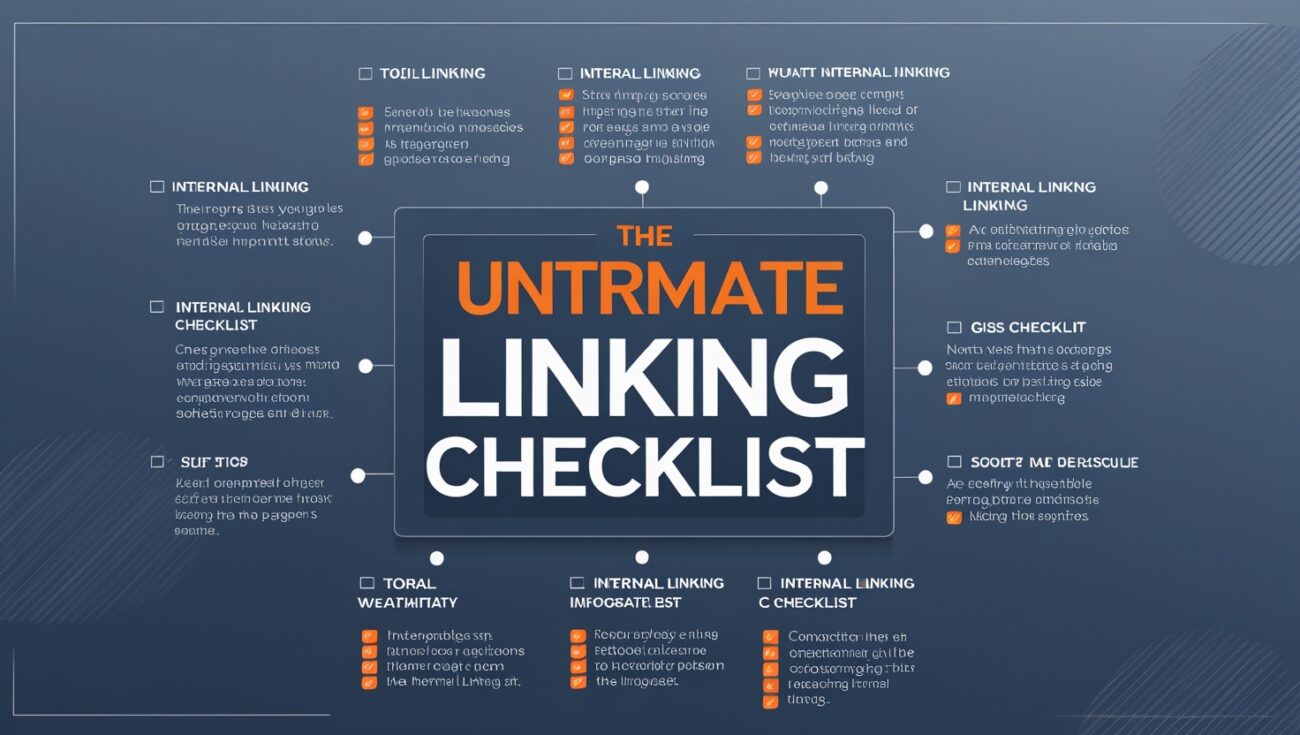The Ultimate Internal Linking Checklist
When you’re trying to build a website that ranks in Google, it’s easy to feel overwhelmed. There are a million things to do, and it can be hard to know where to start. But I’ve learned that the most powerful improvements often come from a simple, systematic approach to internal linking. Instead of feeling lost, I created a checklist to guide me, and it completely transformed my website’s performance.

Table of Contents
This is the ultimate internal linking checklist I wish I had when I started my blog. It’s not a list of vague ideas; it’s a series of simple, actionable steps that you can take right now to dramatically improve your website’s SEO. By following this list, you’ll be creating a powerful, organized, and SEO-friendly network that Google loves.
The Core Internal Linking Checklist
Item 1: Find All Your Orphaned Pages
Orphaned pages are a silent killer. They are valuable pages on your site that have no incoming internal links from any other page, making them almost invisible to search engine crawlers. Your first step is to find these pages and link them into your site’s main structure. It’s a huge, easy win. I use a tool like Linkbot to easily find all of my orphaned pages.
Item 2: Link from High-Authority Pages
Not all links are created equal. Your homepage, your most popular blog posts, and your best-ranking articles have the most link equity to share. Make a list of these high-authority pages and then link from them to your most important content (like product pages or pillar articles) to give them an SEO boost.
Item 3: Use Descriptive Anchor Text
The anchor text—the clickable words of your link—is a crucial signal. Stop using generic phrases like “click here” or “learn more.” Instead, use descriptive, keyword-rich phrases that tell both the user and Google exactly what the destination page is about. This is a simple but incredibly powerful change.
Item 4: Create Topical Clusters (Hub & Spoke)
Think of your website’s content in terms of topical clusters. Create a central “hub” page for each main topic on your site. Then, write more specific “spoke” articles that link back and forth to the hub. This creates a clear, organized structure that signals your expertise and helps your entire cluster of articles rank better.
Item 5: Fix All Broken Internal Links
A broken internal link is a dead end for link equity, a source of crawl errors, and a frustrating experience for your users. You must fix them. If the destination page has moved, update the link. If the page is gone, find a new, relevant place to link to or simply remove the link. You can easily find all of your broken internal links with a tool like Linkbot.
Item 6: Ensure Your Homepage Links Strategically
Your homepage is often the most powerful page on your entire website. The links on it carry immense authority. Make sure you are using them strategically to point to your most important “Pillar” pages and your most valuable content.
The Ongoing Maintenance Checklist
This is not a one-time fix. To maintain a strong internal link profile, you need to make it an ongoing habit.
- Checklist Item 7: Link from New Content: When you publish a new article, take a few minutes to go back to 2-3 old, relevant articles and add a link to your new content.
- Checklist Item 8: Monitor for New Broken Links: As your site grows, links can break. You need to regularly monitor for new broken internal links and fix them as soon as they appear.
- Checklist Item 9: Update Old Links: Go back to your old content and look for new opportunities to link to new articles. This keeps your entire site feeling fresh and interconnected.
The Ultimate SEO Hack: Automation
Manually following this checklist on a large website can feel impossible. That’s why I started using automation. Automated internal linking software can analyze your website and provide a prioritized, actionable list of linking opportunities. It’s the ultimate productivity hack that ensures you never miss a chance to build a stronger website. Ready to take the guesswork out of internal linking? Explore how Linkbot can simplify the process today.
Conclusion: Take Control of Your SEO
This checklist transforms internal linking from an overwhelming mystery into a clear, manageable process. By following these steps, you are not just improving your SEO; you are building a stronger, more user-friendly website. Don’t let your valuable content go to waste. Start using this checklist today and watch your website’s performance soar.
My journey taught me that a major mistake is seeing internal linking as a chaotic, overwhelming task. By creating and following a simple checklist, I moved my focus from feeling overwhelmed to feeling completely in control. This mental shift transformed my website from a chaotic mess into a powerful, organized, and predictable machine.
The long-term, compounding effect of this systematic approach is what makes it so powerful. Each time you check off a box on this list, you are not just performing a task; you are building your website’s authority, one link at a time. These small, consistent improvements add up to a significant competitive advantage over the long term, making your website an increasingly powerful asset.
I can say from personal experience that there is a special kind of satisfaction that comes from cleaning up a messy internal link profile. It’s the feeling of taking a tangled mess of wires and organizing them into a clean, logical network. The result is a website that just feels better to navigate, for both users and the people managing it.
A clean internal link profile also has a huge impact on your website’s overall trustworthiness and authority. When a user or a search engine bot lands on your page and sees a clear network of interconnected, relevant articles, it signals that you are a serious, comprehensive resource on the topic. This kind of professional organization is exactly what Google looks for.
The most important part of this foundational skill is building a consistent habit of following the checklist. It’s not about a single audit and then forgetting about it. A good website is a living thing, and it needs regular maintenance to ensure your internal links stay clean, which is a key part of long-term SEO success.
I felt like I was finally in the driver’s seat of my SEO. For years, I had relied on external factors, which felt like I was giving up control of my SEO destiny. But by mastering a simple task like following this checklist, I was proactively building my site’s authority from the inside out, on my own terms, which was an empowering and exciting feeling.
By implementing this checklist, you are also directly addressing Google’s E-E-A-T framework. You are demonstrating expertise by creating topical clusters, you are showing authority by linking from strong pages, and you are providing a better user experience, which is a key part of what Google looks for in a trustworthy website.
I’ll never forget the first time I applied this checklist to a page that was struggling to rank, and it shot up in the search results almost overnight. It was at that moment I realized that these small, seemingly insignificant steps could lead to a massive, tangible win. It gave me the confidence to keep going.
One of the greatest benefits I got from using an automated tool to manage my link profile was the “to-do” list it provided. Instead of being overwhelmed by the sheer size of my website, the tool gave me a prioritized, actionable list of fixes to make. It transformed a monumental, frustrating task into a series of manageable steps that I could check off one by one.
It’s crucial to understand that this is not just a generic SEO checklist. It is a specific, actionable guide designed to help you build a powerful, interconnected website that benefits both users and search engines. It’s the simple roadmap that turns good intentions into real results.
Ultimately, this internal linking checklist is the secret to a happy, healthy, and high-ranking website. It’s a powerful, low-cost strategy that ensures your website is always working for you, not against you.
My final piece of advice is to not be intimidated. Start with one item on this list, check it off, and then move on to the next. You will be amazed at the progress you make and the results you can achieve with a little bit of consistency and a clear plan.

